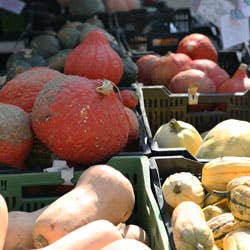
The Great Pumpkin
Inspiration awaits you at the market, where stalls are brimming with delicious squashes of every shape and color. So, leave the jack-o’-lanterns to the kids, and head to the kitchen!
Pity the pumpkin. For too long America's icon of autumn has been typecast as a decorative accessory, destined only to be carved into sinister shapes and left to rot on the front stoop. But the charms of this ancient fruit extend far beyond its showy, rotund profile. Though it is now primarily associated with costumed kids, pilgrims, and pies, the sweet-fleshed and versatile pumpkin has long been a bedrock element in cuisines across civilizations and continents.
Pumpkins have been cultivated in Mexico and Latin America since before 5500 b.c. and are still preserved as calabaza en tacha_,_ a syrupy, sweetened holiday dessert, and used widely in savory vegetable dishes and as a natural thickening agent in stews and soups. Roasted pumpkin seeds, or pepitas, are ground into complex mole sauces, sprinkled onto gooey dulce de leche candies, and blended into Horchata, a cool, milky rice drink. Throughout North Africa and the Middle East, pumpkins are slow-cooked into hearty tagines, whisked into creamy soups, and sweetened, chopped, and molded into a dessert the Turkish call kabak tatlisi. The Greeks, never ones to be outdone, are also passionate about the pumpkin, fashioning it into pies (both sweet and savory), fried patties, layered pumpkin and cheese tarts, pumpkin and snail stews, and pumpkin, chestnut, and pepper sautes. Indeed, in Greece, pumpkin seeds are such a popular and enduring snack that their Greek name is pasatempo, "pastime".
So, why do Americans have so much trouble thinking outside the pie? Maybe it's the willful ignorance of an adolescent country still eager to distance itself from the tastes of its nursery years. When the first settlers arrived on American soil, American Indians already had an arsenal of uses for the pumpkin, from furniture (dried pumpkin strip mats) to food (fire-roasted pumpkin slices). Colonial Americans picked up their tricks and embraced the great squash, soaking it, boiling it, mashing it, stewing it, straining it, and fashioning it into all manner of dishes, from "Indian cake" to pumpkin sauce, pumpkin custard, pumpkin bread, baked stuffed pumpkins, and, of course, pumpkin pie. That's a lot of pumpkin. They even incorporated grated dried pumpkin into one of their favorite tavern tipples, flip—a practice that is immortalized in an old rhyme: "Oh, we can make liquor to sweeten our lips / Of pumpkins, of parsnips, of walnut tree chips." Could it be that the American collective unconscious has the same associations with pumpkins that remorseful college graduates have with tequila?
Or perhaps the problem lies in the name pumpkin—a woefully imprecise moniker that's now mainly applied to any round, orange, deep-grooved, stiff-stemmed member of the Cucurbita family of fruit. The word derives from the Greek word for melon, pepon, and the French term pompion, meaning cooked by the sun. In fact, though, all pumpkins are squash—relatives of the hearty, thick-skinned varieties like butternut and acorn that we call "winter" squash. (That name is actually something of a misnomer, too, since "winter" squash are in fact warm-weather crops that happen to store well over the cooler months.)
But just as they vary wildly in color and shape, some squashes are much tastier than others. The archetypal "pumpkin", the one that evokes black cats and Washington Irving's Headless Horseman, is usually one of a handful of large, uniform breeds: the trick or treat, the jumpin' jack, the magic lantern, or the "father" of all commercial pumpkins, the howden, which was engineered and mass-produced by a farmer named Jack Howden in the 1970s and almost single-handedly drove heritage-breed pumpkins off the map. Unfortunately, attractive though they might be, these popular pumpkins rarely make for good eating. In fact, thanks to their thick, firm shells and stringy insides, those great globes are about as edible as the plastic trick-or-treat buckets for sale at your local megamart.
If Americans are going to reclaim their pumpkin-eating past, they are going to have to hark back to regional recipes and old-fashioned breeds and embrace them warts and all (literally: have you seen the pocked flesh of a galeux d'eysine?). Pumpkin pies may be best concocted with the Canned Stuff (which, while we're on the subject, is made not from the kind of hulking pumpkin Linus pined for but from the squat and far less flashy dickinson squash). Still, there's a veritable world of pumpkin possibilities out there, from Argentine carbonada criolla to pueblo pumpkin and pumpernickel bread, waiting to be explored.
All you have to do is pick one.
Keep Reading
Continue to Next Story










